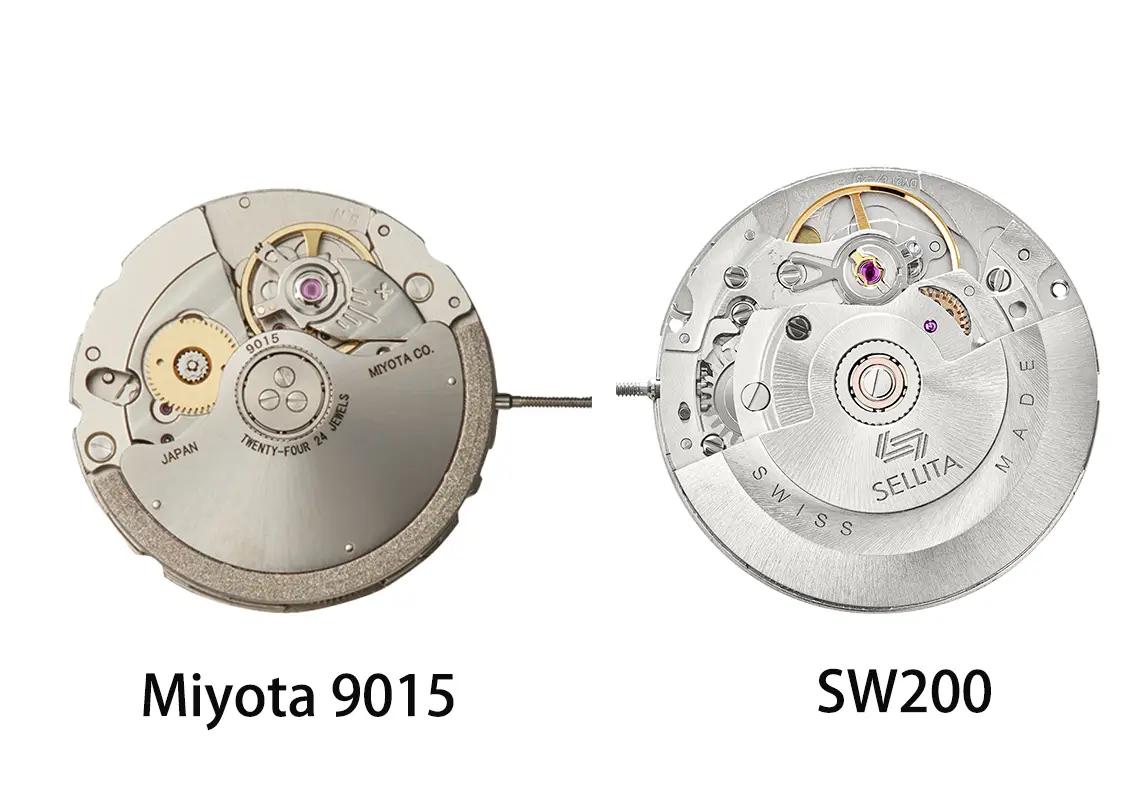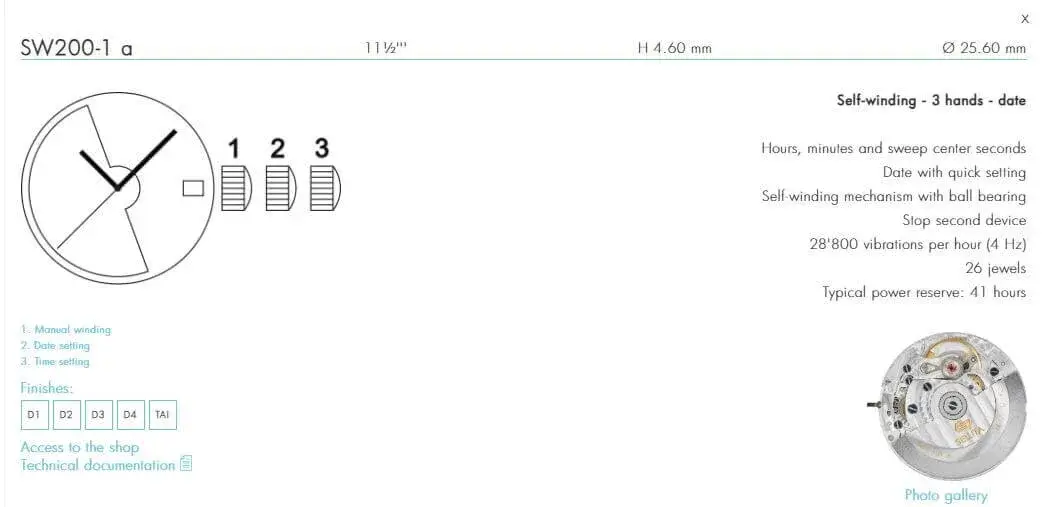Ostatnio rozmawiałem o projekcie z jednym klientem. Jest zdenerwowany, z którego ruch wybrać. podczas gdy wielu klientów ma takie same problemy z wyborem ruchu. Muszą wziąć pod uwagę każdy aspekt projektowania zegarków, więc sprawia, że ludzie trudno jest wybierać.

Więc Japonia kontra ruch szwajcarski, jaka jest ich zaleta?
- Ruchy japońskie są idealne dla przystępności cenowej, trwałości i innowacyjnej technologii.
- Szwajcarskie ruchy wyróżniają się kunsztem, luksusem i dziedzictwem, o silnej wartości odsprzedaży.
- Ich różnice: ruchy Japonii są montowane w linii produkcyjnej, podczas gdy ruchy szwajcarskie są ręcznie wykonane; Zatem różnice kosztów są ogromne.
Japońskie i szwajcarskie ruchy zegarków są bardzo szanowane na całym świecie, ale każde z nich ma wyraźne zalety zaspokojenia różnych preferencji i potrzeb.

1. Ruchy japońskie
- Kluczowi producenci: Seiko, Citizen (Miyota) i Casio są jednymi z najlepszych japońskich producentów ruchu. Ci producenci, o których wspomniałem w tym poście, możesz sprawdzić więcej szczegółów tutaj.
- Zalety:
- Niezawodność i trwałość: Ruchy japońskie, zwłaszcza kwarc, są znane ze swojej solidności i długotrwałej wydajności. Często wymagają minimalnej konserwacji i dobrze radzą sobie z codziennym zużyciem.
- Przystępność cenowa: Ruchy japońskie, zwłaszcza kwarc, są ogólnie bardziej opłacalne niż ruchy szwajcarskie. To sprawia, że są popularne zarówno w zegarkach średniej, jak i przyjaznych budżetowi.
- Innowacyjna technologia: Japońskie marki mają pionierem technologii, takich jak Spring Drive Seiko (ruch hybrydowy łączący dokładność kwarcu z ruchem mechanicznym) i zegarki zasilane energią słoneczną. Są znani z obejmujących zaawansowane technologicznie, najnowocześniejsze innowacje.
- Precyzja: Japońskie ruchy kwarcowe są bardzo dokładne, a nawet ich automatyczne ruchy oferują dobrą precyzję w niższej cenie.
- Najlepsze dla: Osoby poszukujące wartości, niezawodności i nowoczesnej technologii, zwłaszcza jeśli jest kluczowym czynnikiem przystępności cenowej.
2. Ruchy szwajcarskie
- Kluczowi producenci: ETA, Sellita, Ronda i wewnętrzne ruchy od marek takich jak Rolex, Omega i Patek Philippe.

SW 200 SW300 - Zalety:
- Dziedzictwo i prestiż: Ruchy szwajcarskie mają długotrwałą tradycję horologiczną z wieków. To dziedzictwo przyniosło szwajcarskie zegarki z reputacją luksusu i drobnego kunsztu.
- Wysokie kunszt: Ruchy szwajcarskie, szczególnie mechaniczne, znane są z skomplikowanego projektu i dbałości o szczegóły. Często zawierają piękne wykończenia, takie jak Perlage, Paski Genewskie i Anglage (ręcznie wypolerowane krawędzie).
- Długowieczność i wartość odsprzedaży: Szwajcarskie ruchy mechaniczne są znane ze swojej długowieczności i często mogą trwać pokolenie z odpowiednią konserwacją. Wysokiej klasy szwajcarskich zegarków mają tendencję do zachowania lub nawet doceniającej wartość z czasem.
- Dokładność ruchów mechanicznych: Ruchy szwajcarskie, zwłaszcza te certyfikowane przez COSC (Contrôle Offifil Suisse des Chronomètres), oferują wysoką dokładność w zegarkach mechanicznych, chociaż mogą nie osiągnąć precyzji kwarcu.
- Najlepsze dla: Kolekcjonerzy, luksusowi nabywcy i ci, którzy doceniają rzemieślnicze kunszt i prestiż związany ze szwajcarskimi zegarkami.
Różnice w ich cenach i rozważania
Na przykład ten sam wygląd funkcji, wszystkie mają 3 ręce+ datę.
SELITA SW200 vs SW 300 Ruch, vs MIYOTA 9015 Ruch, porównanie cen.
- SW300 Cena ruchu 215 USD/każda,
- SW300 Cena ruchu 109 USD/każda,
- Podczas gdy miyota 9015 USD 50 USD/ każdy


Jeśli wybierzesz ruch SW 300 lub SW 200, oznacza to, że musisz sprzedawać zegarki za ponad 1000 USD za sztukę.
Jeśli wybierzesz 9015 ruchów, możesz sprzedać tylko 250-500 USD
Kto jest szerszy?
Jaka jest różnica między szwajcarskim a japońskim ruchem?
Cel zbiórki:
Ruch szwajcarski: Ruchy szwajcarskie są wysoko cenione przez zegarmistrzów i kolekcjonerów za swoje kunszt. Wysoka jakość szwajcarskich ruchów zegarków, zwłaszcza części mechanicznych ETA, wyróżnia je. Ruchy szwajcarskie często zawierają misterne dekoracje, od metalowych cięć po wybór klejnotów, w których starannie rozważany jest każdy szczegół estetyczny. Ręczny montaż jest nadal powszechny w ruchach szwajcarskich, zwiększając ich cenę i wyłączność.
Cena:
Chwila Ruchy japońskie są zazwyczaj bardziej przystępne cenowo, szwajcarski zegarmistrz ma stulecia tradycji, pochodzący z XVI wieku. Natomiast japońskie ruchy zyskały na znaczeniu w XX wieku. Pomimo krótszej historii w horologii, Japonia opanowała sztukę tworzenia niedrogich luksusowych zegarków. Jednak szwajcarskie zegarki są nadal uważane za złoty standard jakości. Dbałość o szczegóły w ruchach szwajcarskich, od cięć metali po mechaniczne dekoracje, wpływa na ich wyższą cenę. Ręczny montaż, w porównaniu z poleganiem Japonii od zautomatyzowanych procesów, również zwiększa koszt szwajcarskich zegarków.
Produkcja:
Ruchy japońskie: Ruchy japońskie są składane przede wszystkim przez robotyczne linie produkcyjne, zmniejszając błąd ludzki. Chociaż nie mogą skupić się na skomplikowanych szczegółach, lekko „surowy” wygląd części mechanicznych przemawia do wielu. To podejście oparte na wydajności sprawia, że japońskie ruchy są tańsze. Pomimo koncentracji na precyzji i funkcjonalności ruchy japońskie nadal utrzymują dobrą jakość, chociaż estetyka nie jest głównym celem.
Aktualizacja:
Ze względu na różne projekty, produkcję i procesy montażowe zarówno szwajcarskich, jak i japońskich ruchów, trudno je bezpośrednio porównać. Na przykład renomowany szwajcarski ruch ETA Valjoux 7750 występuje w różnych klasach, w których wersje droższe mają lepsze części i bardziej skomplikowane dekoracje. Natomiast ruchy japońskie zazwyczaj nie oferują takiej zmienności, ale ich przystępność cenowa ułatwia ulepszenie całego mechanizmu.
Ostateczne podsumowanie:
Ogólnie rzecz biorąc, ruchy japońskie bardziej koncentrują się na funkcjonalności, podczas gdy ruchy szwajcarskie bardziej koncentrują się na rzemiośle.
Jeśli skupiasz się na tej stronie, wybierz swoją strategię marketingową. Jeśli chcesz skupić się na drogich, luksusowych zegarkach, wybierz ruchy szwajcarskie. Jeśli chcesz sprzedawać więcej zegarków, promować swoją markę i chcesz, aby Twoje produkty były do noszenia i użyteczne przez społeczeństwo, użyj japońskich zegarków markowych i wybierz japońskie ruchy w zegarkach kwarcowych oraz wybrać wysokiej klasy japońskie ruchy lub szwajcarskie ruchy w zegarkach mechanicznych.

